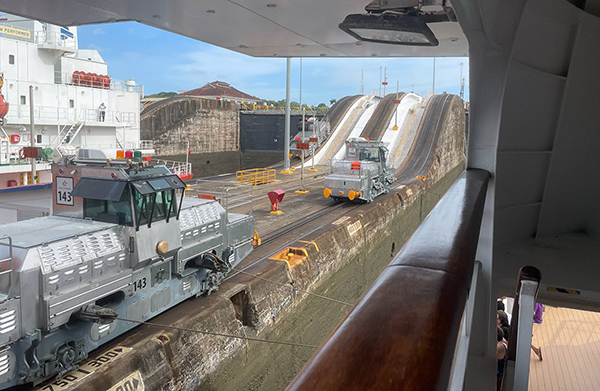

|
|
 |
 |
|
April 25, 2025 Marti Eicholz In the predawn sky, before sunrise, looking east, there is a rare and playful alignment. Venus and Saturn aligned with a crescent Moon, lighting up the early sky, creating a radiant smile, a celestial emoji you won’t forget. Did you see the beautiful “cosmic smile” smiling at you? December 16, 2024, The Odyssey made its first crossing of the Panama Canal. Now we get in the queue to cross again with fresh new eyes and a spirit of wonder and awe. Panama is a fast-growing destination in Central America and the star attraction is the Panama Canal. The Panama Canal, a man-made waterway, connects the Atlantic and Pacific Oceans across the Isthmus of Panama, extending from Colon on the Caribbean Sea to Balboa on the Pacific Ocean, a crucial route for maritime traffic, playing a vital role in global trade. Prior ships sailed around the tip of South America, traveling nearly 12,500 miles. This shortcut, allowing ships to bypass the long journey around South America, takes about eight hours to cross the Canal’s fifty miles, saving days and reducing travel costs moving from one ocean to another. The success of the Suez Canal, connecting the Indian Ocean and the Mediterranean Sea, motivated the French in 1881 to make an agreement and a plan with the Colombian government to begin construction of the canal. Miscalculations, planning deficiencies, diseases, poor organization, engineering problems, high worker mortality, and bribes caused the company to go bankrupt in 1889. Construction stopped. Now the Americans showed interest, wanting to finish the work begun by the French. The Colombians refused. President Roosevelt sent a warship to the region, occupying, killing the militia leader, proclaiming the state of Panama and restarting the building process. In 1904, the US took charge, completing the project with modern technology. Ten years later in 1914 the first ship passed the exit to the Pacific Ocean. More than 43,000 people worked on the Panama Canal at one time. Workers dealt with heat, jungles, swamps, creatures like rats, carrying bubonic plague, and mosquito-borne diseases like yellow fever and malaria. During the French building efforts, over twenty thousand able-bodied workers died. During construction from 1881 – 1914, over 30,000 workers died. In 1999 the United States returned control of the Canal back to Panama. Today, more than 14,000 ships pass through the canal each year, saving a detour of 7,900 miles around Cape Horn and avoiding some of the most dangerous waters. 2025 marks the 111th anniversary of the opening of the Panama Canal. The Panama Canal is designated as one of the 7 Wonders of the Modern World and one of the largest, most difficult engineering projects undertaken. Every ship passing through the canal pays a toll based on size, type, and volume of cargo. Cruise ships pay by number of passengers in beds. The smallest toll was paid by an American in 1928. He paid thirty-six cents to swim the Canal. The original canal locks for a century accommodated shipping needs, but ships kept getting bigger. So, in 2007 work began to expand the Canal, involving new locks at either end of the Canal and making the existing channels wider, deeper, and straighter. In 2016, this third, wider lane of locks opened to accommodate larger vessels, further enhancing the canal’s capacity that can carry 14,000 20-foot shipping containers (three times the original ship capacity). Even with this giant step in 2016, today’s largest container ships, carrying 18,000 containers, cannot pass through the Canal. The Odyssey will pass through a total of six lock chambers during our transit. The Odyssey is scheduled to enter the Gatun Locks around four p.m. We will be on deck watching and listening to our guide and narrator, Gus, give commentary as our ship makes its passage through a total of forty-six gates and twelve locks. The canal uses a lock system, raising and lowering the ship as they navigate the different elevations. The Panama Canal has twelve locks, organized into three sets: Gatun, Pedro Miguel, and Miraflores. Each set has two parallel lanes, allowing ships to pass in opposite directions at the same time. Locks on the Atlantic side, lifts the ship from sea level to the height of Gatun Lake, then lowers it to the other ocean. The Pedro Miguel Locks on the Pacific side have one step, lifting the ship from the Pacific Ocan to Miraflores Lake. Also on the Pacific side, the locks have two steps, lowering from Miraflores Lake to sea level. The new locks have three chambers holding thousands of liters of water. Once the gates close, water flows into the chamber, raising the ship high enough to enter the next chamber. The system repeats until the ship passes through all three chambers, ready to sail onto the lake. The new locks use tugboats to guide the ship safely through the locks. The old locks still use electric towing locomotives “mules” (a cable) to pull the ship through the chambers. Every ship passes through the locks under their own propulsion. “Mules” and “tugboats” are used to keep the ship centered in the chambers. The transit time to pass through the Panama Canal, from one ocean to the other is an average of eight to ten hours, depending on the size and type of ship, traffic congestion, and weather conditions. |
|
Copyright © 2025 All rights reserved |